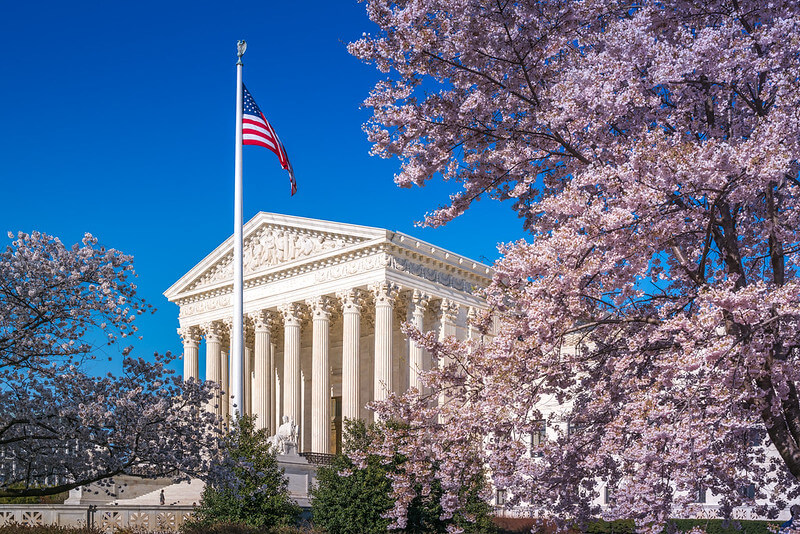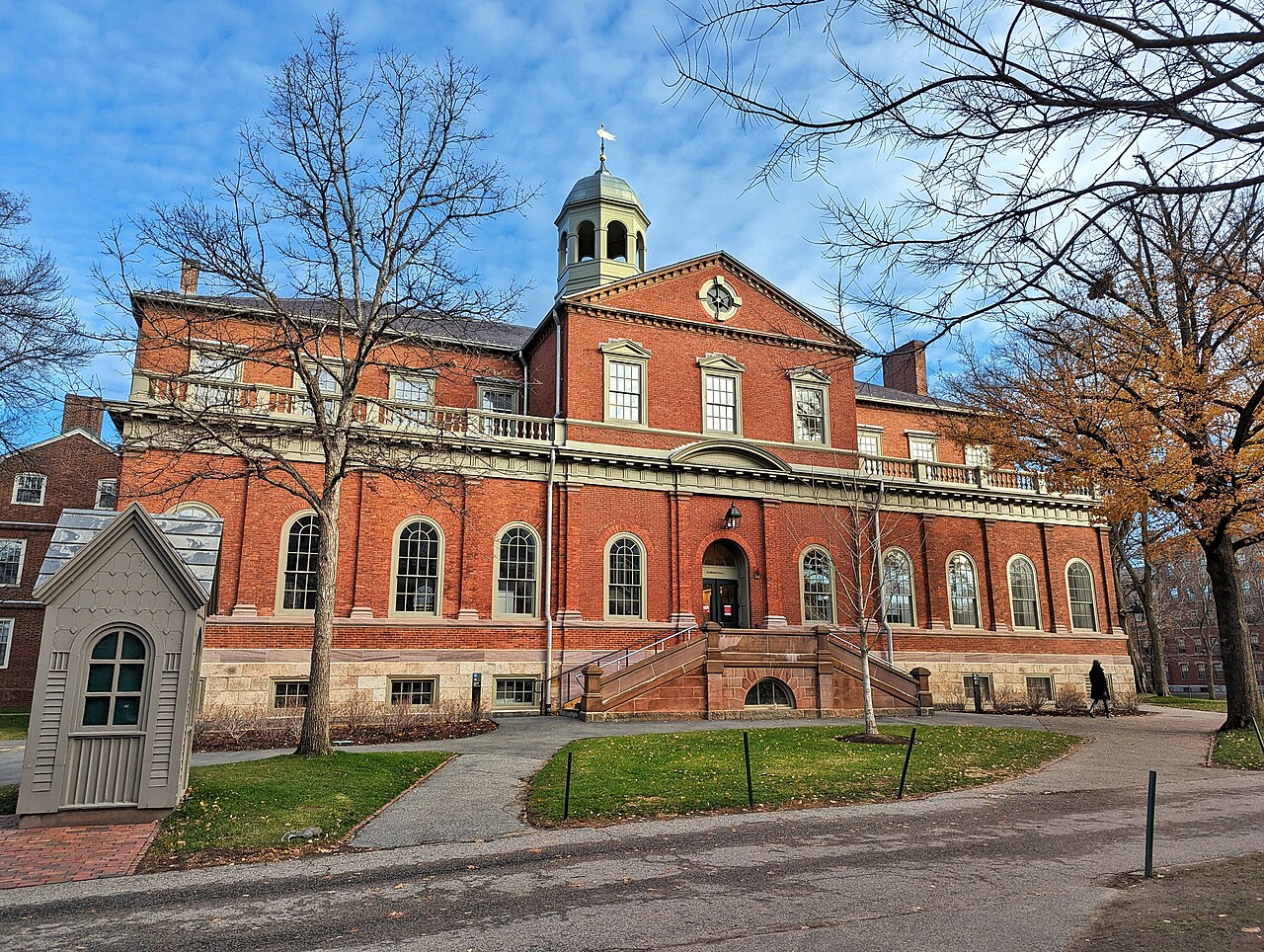A Chance for the Courts to Rein in Governing by Emergency
Two seemingly unrelated Supreme Court cases up for oral argument in the next few weeks will

Published by The Lawfare Institute
in Cooperation With

In a few weeks, the Supreme Court is scheduled to hear oral argument in two seemingly unrelated cases concerning the use of pandemic-related emergency powers—one about canceling student loan debt and one about the influx of migrants at the southern border. The public debate has largely not grappled with the separation of powers issues presented by both cases, focusing instead on the merits of the underlying policies. But the proper use of emergency powers by the executive branch—and the role the courts play in enforcing it—has important implications for the long-term health of democracy in the United States. That’s why our organization, Protect Democracy, filed amicus briefs in both cases asking the Supreme Court to treat them holistically as emergency powers cases and proposing a standard for how the Court should consider challenges to executive actions based on congressional delegations of emergency powers. Even as the Biden administration prepares to end the coronavirus emergency, the Court will still have a major say in how emergency authorities can be used.
The first case, Biden v. Nebraska, and its companion case, Department of Education v. Brown, concern the Biden administration’s plan to cancel more than $400 billion in student debt. The administration maintains that borrowers with incomes below $125,000 (or household incomes below $250,000) were placed in a worse financial position because of the coronavirus pandemic and are entitled to relief under the terms of the Heroes Act of 2003 and the National Emergencies Act (NEA) of 1976.
The Heroes Act, first enacted in the wake of the 9/11 terrorist attacks and later extended to cover all those serving in the military and persons affected by national emergencies, allows the secretary of education to “waive or modify any statutory or regulatory provision applicable to” student aid programs administered by the Department of Education if “a national emergency” caused student borrowers to be “placed in a worse position financially.” Because the Heroes Act confers special powers on the executive branch in the context of a “national emergency,” which “means a national emergency declared by the President of the United States,” the exercise of those powers is unlocked by the NEA—the overarching framework Congress established both to facilitate and to constrain executive action in response to national emergencies.
The second case, Arizona v. Mayorkas, involves an attempt by a group of Republican-led states to force the Biden administration to continue using emergency powers available under 42 U.S.C. § 265, commonly known as Title 42, to limit travel into the United States from other countries if “required in the interest of the public health.” Title 42 is an emergency power available to the Centers for Disease Control and Prevention (CDC) to mitigate a public health crisis. A companion provision, 42 U.S.C. § 247d, empowers the secretary of health and human services to declare public health emergencies. The Trump and Biden administrations both issued public health emergency declarations based on the coronavirus pandemic. Both also used Title 42 to restrict migration at the southern border and to supersede laws governing political asylum, purportedly to quell the spread of the virus, drawing sharp criticism in the process.
However, the Biden administration has since determined that the Title 42 restrictions are no longer justified by the pandemic. And now it has announced that it will be ending the public health emergency on May 11, 2023, at which time all Title 42 restrictions still in place will also end. The Republican-led states are attempting to intervene in the case, in which a lower court invalidated the Title 42 restrictions, as part of a larger effort to require the administration to continue to exercise Title 42 emergency powers restricting travel regardless of the CDC’s determination that the restrictions are no longer justified by a public health crisis. Notably, the Court’s decision to consider the states’ motion to intervene and to stay the underlying case in the meantime drew a rebuke from Justice Neil Gorsuch (joined by Justice Ketanji Brown Jackson), who took exception to the Court overstepping its role, writing “[w]e are a court of law, not policymakers of last resort.”
Policy merits aside, both cases involve efforts to leverage special powers delegated to the executive branch for use in national emergencies to address distinct long-standing problems that are not the result of the pandemic emergency, bypassing Congress in the process. Such executive actions are increasingly common given the perceived ease with which presidents deploy emergency powers and Congress’s inability to address complex problems. President Trump’s declaration of a national emergency for the specific purpose of overriding Congress on funding for a border wall was an ominous harbinger of this trend.
Of course, Congress is hardly blameless in allowing this to happen. It could and should pass reforms to the NEA that already have significant bipartisan support and that would require approval from Congress before an emergency declaration could continue after a set period of time. As Bob Bauer and Jack Goldsmith noted recently here in Lawfare, NEA reform is ripe for action this Congress. But in the meantime, the Court should pay special attention to its own role in preventing exercise of emergency powers that are beyond what Congress intended to authorize. The history and text of congressional emergency delegations demonstrate that Congress intended to give the executive branch the ability to respond to unforeseen events with immediate short-term action that Congress is ill suited to address. But it did not intend to cede power to the president or the courts to govern by permanent emergency decree—a condition that the framers of the Constitution identified as a recipe for tyranny. As our briefs argue, the Court should adopt an approach to reviewing executive emergency actions that gives full effect to Congress’s purpose in delegating emergency authority and that ensures that neither the executive branch nor the courts themselves supplant the legislative process contemplated by the constitutional system of checks and balances.
The History and Purpose of Congressional Delegations of Emergency Powers
The statutory schemes governing the use of emergency powers in the United States rest on a basic premise: Emergency powers are both necessary and potentially dangerous. The normal bicameral legislative process is poorly suited to quick responses to unforeseen problems, so Congress has long recognized the need to give the executive branch the authority to act in those situations. At the same time, “emergencies”—both real and manufactured —have served as the backdrop for serious abuses of power, often at the expense of civil rights and liberties.
President Truman used the exigencies of the Korean War as justification to seize control of the steel industries during a strike in 1952, which the Supreme Court struck down in Youngstown Sheet & Tube Company v. Sawyer. President Roosevelt used the Japanese attack on Pearl Harbor as justification to round up Japanese Americans and place them in internment camps, a move the Court upheld at the time in Korematsu v. United States but has since repudiated. More recently, President Trump manufactured an emergency at the southern border to access funding Congress had refused to give him to build a border wall, denigrating Mexican and Central American migrants, as well as Latino members of the American border community, in the process. Trump also considered using emergency powers to seize voting machines following his election defeat in 2020. This isn’t a uniquely American phenomenon—aspiring autocrats around the world often invoke shaky emergencies to aggrandize power.
As Justice Robert Jackson wrote concurring in Youngstown, the Constitution’s framers understood that emergency powers “afford a ready pretext for usurpation,” and “they suspected that emergency powers would tend to kindle emergencies.” Congress has also understood these dangers and has taken care to forestall them when conferring emergency authority on the executive. In 1976, in the wake of the Watergate scandal, Congress enacted the NEA to limit the future use of emergency powers to those situations “when emergencies actually exist, and then only under safeguards of congressional review.” The point of the law was to prevent the president from “rul[ing] the country without reference to normal constitutional process” and to place limits on presidential use of emergency powers.” And as the legislative history makes explicit: “The National Emergencies Act is not intended to enlarge or add to Executive power. Rather the statute is an effort by the Congress to establish clear procedures and safeguards for the exercise by the President of emergency powers conferred upon him by other statutes” (emphasis added).
Congress did not grant the president any new or specific emergency authorities through the NEA but, instead, made a series of changes to the process by which presidents can access them in order to protect the separation of powers. Most critical among these were giving presidents the authority to declare an emergency (and thus access attendant statutory powers) that they were required to specify and keeping for itself the power to terminate emergencies by a simple majority vote of both chambers.
Congress’s use of the term “emergency”—rather than, say, “national crises” or “national issues of grave importance”—is telling. The ordinary meaning of “emergency” in 1976 (as it remains today) was “[a] situation or occurrence of a serious nature, developing suddenly and unexpectedly, and demanding immediate action.” While grants of statutory authority that authorize presidents to respond to inherently unforeseen circumstances will necessarily be broad, that does not render Congress’s delegation unlimited. Congress’s use of “emergency” makes clear that presidents may invoke these extraordinary powers only when the problem of national importance is “sudden” or “unexpected” and requires the kind of “immediate action” that the legislative process is often ill suited to provide.
The Supreme Court’s 1983 ruling in INS v. Chadha dealt a major blow to Congress’s ability to police the president’s use of emergency powers. In holding concurrent resolutions to be unconstitutional “legislative vetoes,” the Court gave the president veto power over emergency terminations (which Congress later codified), making emergencies “easy to declare and hard to stop,” according to Elizabeth Goitein.
The undoing of the legislative veto is one of the principal drivers in the current bipartisan effort to reform the NEA, and there is no question that Chadha—and Congress’s response to it—weakened the NEA as a guardrail against abuses of emergency powers. However, the fact that Congress codified the Court’s requirement that termination resolutions be presented to the president does not mean that it intended to confer unreviewable authority to act outside the context of an “emergency,” as that term is commonly understood. What it does mean is that the courts now serve as the principal check on the executive’s use of emergency powers in accordance with congressional intent.
Of course, while the NEA is the overarching framework governing access to at least 123 underlying emergency authorities—including provisions of the Heroes Act—there are other statutes conferring emergency authority, including various authorities allowing the declaration of public health emergencies and the use of attendant powers that share similarities with the NEA, including 42 U.S.C. § 247d and 42 U.S.C. § 265, both of which are part of the statute establishing public health services enacted in 1944.
The provision of Title 42 at issue in Mayorkas confers authority on the CDC to suspend “the introduction of persons or property” from other countries when allowing such persons and property into the country would increase the danger of introducing a communicable disease. That broad authority is limited by the statute to “such period of time as [the CDC] may deem necessary” to defend against the danger (emphasis added). The CDC itself explained that Title 42 orders “are, by their very nature, short-term orders authorized only when specified statutory criteria are met, and subject to change at any time in response to an evolving public health crisis” (emphasis added). And the solicitor general has recognized that Title 42 is an emergency authority.
A separate section of 42 U.S.C. § 247d (Section 319 of the Public Health Service Act) authorizes the secretary of health and human services to declare a “public health emergency” if certain conditions are met. The CDC’s Title 42 order governing the border was predicated on the existence of a public health emergency, as declared by the secretary pursuant to that statutory authority. A subsequent CDC order, accordingly, acknowledged that the end of the public health emergency would terminate the Title 42 policy at the border. And importantly, the dictionary definition of “emergency” contemporaneous with the 1944 enactment of the public health law is an “unforeseen combination of circumstances which calls for immediate action” (from Webster’s New International Dictionary of the English Language Second Edition). This is the same definition in use in 1976—and today.
The statutory provision authorizing the secretary to declare a public health emergency includes certain protections to guard against abuse. The authority is time limited, expiring after 90 days unless formally renewed. The secretary is required to submit written notification to Congress of the emergency within 48 hours. And the secretary is required to provide Congress with annual reports on the use of certain funds unlocked by the public health emergency declaration. The overall statutory framework thus demonstrates that Congress thought about emergency constraints in the public health context.
Through these statutory schemes governing emergency delegations, Congress developed an approach to enable the executive to act as necessary in an unforeseen situation requiring immediate action—while indicating its intent to prevent the executive branch from seizing on emergencies to subvert the legislative process and the constitutional separation of powers. In reviewing uses of emergency powers, courts should give effect to that approach—and should not allow the president, or the courts themselves, to use special emergency powers to address situations that do not reasonably qualify as emergencies or are untethered from a declared emergency.
Determining When an Emergency Action Is Authorized
As we argue in our briefs, courts should weigh a set of factors derived from the history and text of congressional emergency delegations and rooted in the meaning of “emergency” to decide whether an executive action is authorized by a given statute.
1. Is the precipitating situation a qualifying emergency, defined as an unforeseen set of circumstances calling for immediate action?
A threshold question in an emergency-related case is whether there is, in fact, a qualifying emergency as defined above. If there is no such qualifying event, invocation of emergency powers is unauthorized.
2. How close is the nexus between the emergency and the action taken?
Courts should examine the nexus between a validly declared emergency and the action taken. The closer the relationship between the emergency and the powers exercised, the more likely the action falls within the scope of what Congress authorized.
3. Do the executive branch’s actions, and the context surrounding its actions, suggest the invocation of the emergency is pretextual?
As emergency powers are intended to be used only in response to unforeseen crises, Congress likely did not intend for the executive to use such powers to effectuate long-standing policy goals. Courts should consider the administrative and legislative records, among other things, to assess whether the executive is using an emergency as pretext to implement policies it would have otherwise sought to implement regardless. For instance, if the executive previously tried, and failed, to get Congress to authorize an action and then invoked emergency authority to accomplish the same goal, there is strong indication the emergency is pretextual. This was the case when President Trump sought a specific amount of funding from Congress for border wall construction, provoked a prolonged government shutdown when Congress passed the Consolidated Appropriations Act specifically limiting spending to an amount significantly lower than his request, and then finally issued an emergency proclamation to access the amount of funds he desired.
4. Does the action result in the longer-term exercise of executive power or aggrandizement of power to the executive branch?
Given that emergencies are understood to be unforeseeable events requiring immediate action, courts can presume Congress did not intend for emergency authorizations to shift power from the legislative to the executive branch over the long term. Likewise, executive actions that constitute a permanent shift in policy are unlikely to fit within the parameters of what Congress authorized when delegating emergency powers.
The Appropriate Role of the Courts in Reviewing Emergency Actions
An analysis predicated on the above factors will help ensure that executive actions do not exceed what Congress authorized. That said, while courts play a critical role in ensuring the lawful use of emergency powers, they can also undermine congressional intent and the separation of powers if they use emergency cases to substitute their own judgment for the executive’s in addressing emergencies or deploying emergency powers.
As the Supreme Court has recognized, the judicial branch is not meant to decide how to execute the law. This is especially so in the context of emergency powers. Courts generally lack the expertise and expediency to craft responses to unforeseen events. And of course, as Alexander Hamilton explained in the Federalist Papers, life-tenured Article III judges are not accountable to the public for their policy choices, another reason policymaking rests with the political branches by constitutional design.
In cases involving emergency statutes, Congress has delegated authority to the executive branch—not the judiciary—to act in an emergency. As Gorsuch recognized in Arizona v. Mayorkas, it would undermine Congress’s legislative decisions for the courts to impose extended states of emergency or mandate that emergency policies remain in place beyond what the executive branch has determined is required:
The only plausible reason for stepping in at this stage that I can discern has to do with the States’ second request. The States contend that they face an immigration crisis at the border and policymakers have failed to agree on adequate measures to address it. The only means left to mitigate the crisis, the States suggest, is an order from this Court directing the federal government to continue its COVID-era Title 42 policies as long as possible—at the very least during the pendency of our review. Today, the Court supplies just such an order. For my part, I do not discount the States’ concerns. Even the federal government acknowledges “that the end of the Title 42 orders will likely have disruptive consequences.” Brief in Opposition for Federal Respondents 6. But the current border crisis is not a COVID crisis. And courts should not be in the business of perpetuating administrative edicts designed for one emergency only because elected officials have failed to address a different emergency.
In light of the risk of the federal judiciary itself exercising emergency powers, courts should be especially cautious, as in the case of Arizona v. Mayorkas, about allowing third-party litigants to use procedural litigation maneuvers—such as intervention and emergency stays—to force the executive branch to declare or prolong an emergency.
The Supreme Court Should Be Skeptical of Both Emergency Actions Now Before It
Consistent with the framework described above, the Court should be skeptical of the Biden administration’s attempt to bootstrap a long-standing student debt crisis—one that Congress has had many years to consider and address—to the coronavirus pandemic, and of the solicitor general’s claim of broad executive power to use the emergency provisions of the Heroes Act to implement permanent student debt cancellation. That argument is based on an expansive reading of the statute that does not account for the broader statutory scheme imposed by the NEA—or for the textual and structural limitations Congress intended to place on the use of emergency powers to end-run the normal legislative process. At the same time, the Court should reject the attempt by a group of states to leverage the judiciary to prolong the exercise of Title 42 emergency powers that the government itself acknowledges are no longer necessary for any public health purpose.
In the face of the well-documented dangers of government by emergency, these two cases present the Court with an important opportunity to articulate a judicial framework that reflects Congress’s intent in delegating narrow and circumscribed emergency authority to the president. Biden’s intentions in relieving generations of Americans from burdensome debt might be laudable, and a surge of migrants at the southern border is both a human rights issue and a severe logistical challenge for border-state governments. But that does not justify jettisoning the legislative process the Constitution mandates for solving long-term policy problems. And after Trump’s border wall gambit, it is not difficult to imagine how the latest executive emergency precedents might be used in a less benign future. The founders understood the threat posed to democracy by executive power grabs and structured the separation of powers to prevent that threat, much as Congress did after Watergate. The courts should perform their own role in a way that heeds the founders’ warning and respects the text and the purpose of emergency powers statutes.









